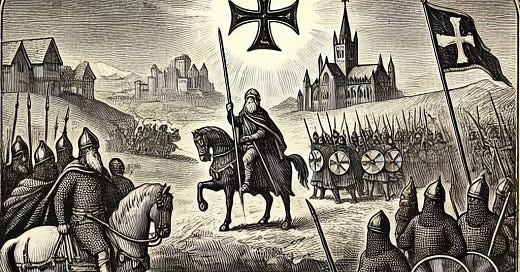The Battle of Athelstaneford, an event shrouded in myth and historical debate, introduces us to a figure known as Athelstane. This Saxon leader’s life and exploits, as recounted in historical texts and local tradition, paint a vivid picture of early medieval warfare and cultural clashes in the British Isles. But who exactly was Athelstane? Let’s delve into the enigmatic story of this leader and his impact on Scottish and Saxon history.
Historical Context: The Time of Athelstane
The battle occurred around A.D. 800, a time of frequent conflicts between the various kingdoms of what is now the United Kingdom. Scotland was divided among several kingdoms, including the Picts, ruled by King Hungus, and the Scots, led by Achaius. The Saxons, from southern England, were also expanding their territories, often clashing with their northern neighbors.
According to historian George Buchanan, the battle took place during Achaius's reign. Athelstane, though often depicted as a Saxon leader, is sometimes mistakenly referred to as a Danish chief. Buchanan's accounts suggest that Northumberland was ceded to him by Alfred the Great. However, this claim is historically dubious, as Alfred the Great reigned later, from 871 to 899. Thus, Athelstane’s true identity remains uncertain, with some sources suggesting he might have been a Saxon chieftain rather than a formal king.
The Invasion of Scotland
Athelstane’s legacy is largely tied to his invasion of Scotland. Leading a Saxon force, he ravaged the territories of King Hungus of the Picts. In response, Hungus sought help from Achaius, King of the Scots, who provided an army of 10,000 men led by his son Alpin. This alliance aimed to repel the Saxon invaders and defend their lands.
The Scots and Picts mounted a counter-offensive, entering Northumberland, wreaking havoc, and seizing considerable plunder. Athelstane, not one to retreat easily, pursued the Scots on their return journey, leading to a decisive confrontation near the village of Athelstaneford, by the Lug Down Burn, a rivulet separating the parish from Haddington.
The Battle of Athelstaneford
The battle is notable not just for its military engagement but for the legendary and miraculous elements woven into its narrative. As the story goes, Hungus, significantly outnumbered and facing a formidable enemy, turned to divine intervention. After setting up camp, he prayed for assistance and fell into a slumber, during which St. Andrew appeared to him in a vision. The Apostle promised Hungus victory, inspiring the Pictish king and his soldiers.
On the day of the battle, an illuminated St. Andrew’s cross reportedly appeared in the sky, a sight that struck fear into the hearts of the Saxons. This miraculous event, reminiscent of Constantine the Great’s vision, turned the tide in favor of the Scots and Picts. The Saxons, disheartened and disoriented by the celestial sign, were swiftly defeated. Athelstane himself was pulled from his horse and slain at the ford of Lug Down Burn, cementing his place in local lore.
The Aftermath and Legacy
The defeat of Athelstane had significant repercussions. The village near the battle site became known as Martle, likely derived from "miracle," in honor of the divine vision that purportedly secured victory. Moreover, the battle and its associated miracle led to the establishment of the Order of the Thistle, Scotland’s highest chivalric order, dedicated to St. Andrew.
While some historians question the very existence of Athelstane, given the lack of mention in sources like the Saxon Chronicle or the works of Fordun, this does not necessarily invalidate the tradition. Athelstane might not have been a king in the formal sense but rather a prominent Saxon leader or chieftain whose exploits left a lasting impression on the region’s history.
Athelstane in Historiography
The story of Athelstane and the Battle of Athelstaneford is primarily derived from historical works like Buchanan’s "History" and the "Statistical Account of Scotland." These sources, while valuable, often blend historical facts with legendary embellishments. For instance, the vision of St. Andrew and the miraculous cross in the sky echo earlier tales of divine intervention in battles, reflecting medieval historians’ penchant for the marvelous.
The legend of St. Andrew’s vision is detailed in the "History of the Blessed Regulus and the Foundation of the Church of St. Andrew," written around 1140. This account aimed to bolster the religious and cultural significance of St. Andrew in Scotland, intertwining faith with national identity.
Conclusion: The Enigma of Athelstane
Athelstane remains an enigmatic figure in British history. His story, whether viewed as historical fact or legend, highlights the turbulent and often mythologized nature of early medieval conflicts. His invasion of Scotland and the subsequent Battle of Athelstaneford exemplify the era's complex interplay of warfare, religion, and cultural identity.
As we explore figures like Athelstane, we gain insight into the rich tapestry of history that shapes our understanding of the past. Whether a real historical figure or a symbolic representation of Saxon aggression, Athelstane’s tale continues to intrigue and inspire, reminding us of the enduring power of legend in shaping historical memory.





